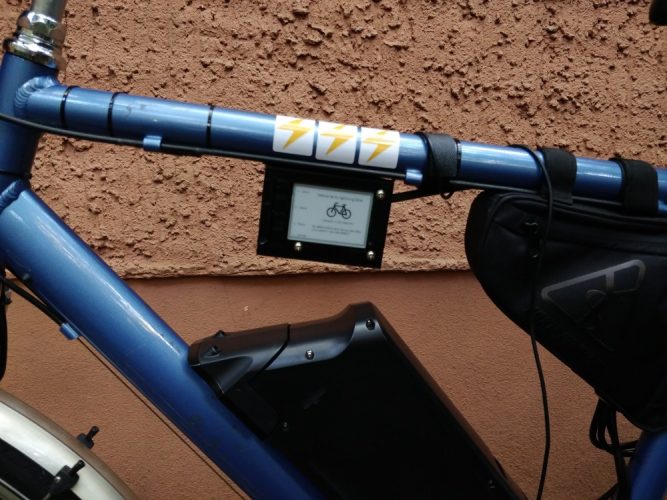Matthias Steinig, a German programmer, has developed a new mechanism that allows e-bikes to be rented in exchange for payments on the bitcoin Lightning Network. A prototype built using a modified bicycle is already fully functional and has been demonstrated in a video posted on Twitter.
The Lightning Bike
The project involves a device connected to the bike that controls the flow of electricity depending on whether or not a payment has been made. The payment process only requires the user to scan a QR code with their mobile phone and can be completed without any technical knowledge.
In its current state, Steinig’s e-bike implementation allows users to pay for temporary electricity replenishments via bitcoin microtransactions. The primary advantage of the Lightning Network is the ability to complete bitcoin transactions within a few seconds instead of several minutes or even hours. Since the payment mechanism has been built on top of the same infrastructure, there is very little delay between an individual initiating payment and being granted access to the bike’s full potential.
The payment mechanism has been designed to be simple and easily accessible. From the project’s official documentation, “You select on the display how long you want to drive, get a QR code that you scan and pay for with your lightning mobile app, after that the power for the selected period is turned on.” Once the time runs out, the user can pay for another refill or pedal the bike at no charge.

(Source: GitHub)
The project, simply titled “Lightning Bike,” is detailed in full on GitHub and has been made completely open source for others to learn from and even replicate. Steinig has only made one such e-bike so far and has not expressed any desire to turn his invention into a commercial operation. Furthermore, almost every single component used is readily available off the shelf or from an online supplier. The only customized parts involved are the project’s code and a 3D printed enclosure to house all the electronic circuitry.
When BTCManager reached out to Steinig, he explained his motivation to create the project. “I wanted to contribute something for the mass adaptation and looked for a use case in which Lightning can be used and prove its stability,” he said.
“But my first Idea was to convert my bike into an e-bike then I got the idea to expand it to the lightning-bike.”
At its core, the accompanying device uses a Raspberry Pi Zero computer that “controls both the connection to the mobile network and the switching of the power supply via a relay.” To display the current status of the bike to the user, a small e-paper display is also mounted at the front. Given that both the single board computer and the display are reasonably energy efficient, they can be run without significant energy loss.
The onboard computer communicates with a remote server over the internet that hosts the Lightning Network payment infrastructure. The server first sends a QR code to the bike, which is shown on the display. Once the user completes the payment using a Lightning Network-enabled wallet app on their smartphone, the server notifies the device. A relay, essentially an electrically operated switch, connected to the Raspberry Pi then provides power for a brief period.
Even though the project is already operational, Steinig plans to continue working on improving his invention and developing new use-cases for the Lightning Network. He said:
“This project is a prototype that is self-contained at the moment. If someone wants to develop it with me, I’m glad. I am currently working on another project, which also deals with lightning and mobility, but I will not reveal more at the moment.”
Lightning Network: The Future of Microtransactions?
The Lightning Bike is one of the several recent real-world applications of bitcoin’s highly anticipated scaling solution, the Lightning Network. Steinig is also optimistic that the network will drive up innovation and adoption of the cryptocurrency. He said, “When I first heard of Bitcoin Lightning at the beginning of the year, I was immediately fascinated by the technology and convinced that it would be a big step forward for Bitcoin.”
The Lightning Network first entered testing in 2017 and saw active participation from the Bitcoin community from the very beginning. By mid-2018, it was not only successfully launched on the Bitcoin mainnet, but also grew to a total capacity of around 100 BTC. Meanwhile, community development for cross-platform applications, wallets, and products has been progressing in full swing. According to data from 1ML.com, the Lightning Network currently has over 4,000 active nodes and approximately 12,000 active payment channels.
The efficiency and speed improvements of the Lightning Network over traditional on-chain payments can potentially enable widespread adoption of bitcoin, especially in the retail sector. In September 2018, for instance, Swiss cafe Energy Kitchen AG unveiled a new “Self Order Point” machine and website that would let users pay for their orders over the Lightning Network. The developer, Oliver Gugger, explained the relatively straightforward payment process on Twitter:
“Scan a QR code, pay it with your #LightningNetwork enabled wallet and get a [randomly]generated order name that you can mention to pick up your order at the coffee bar inside.”







